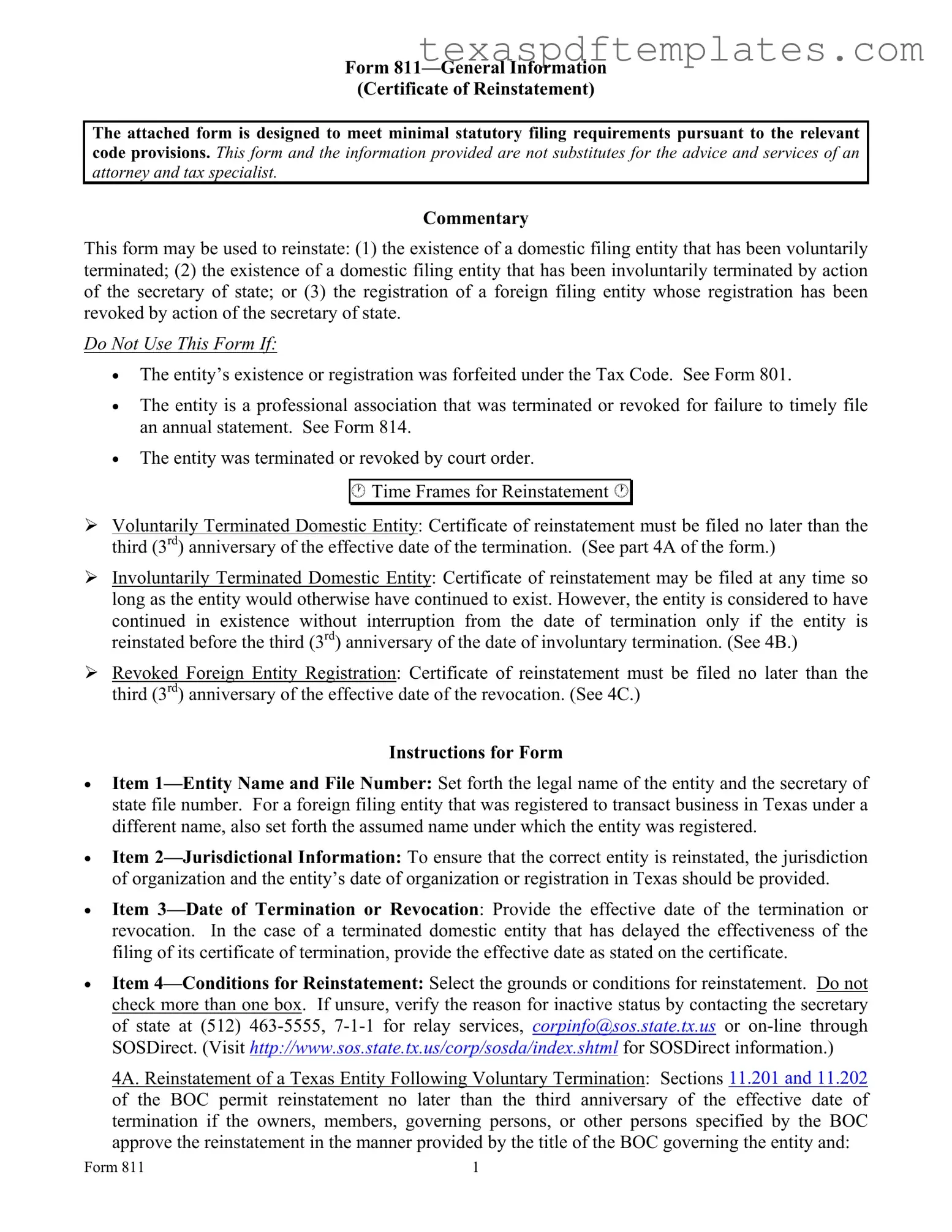(1)the termination was by mistake or was inadvertent;
(2)the termination occurred without the approval of the entity’s governing persons when approval is required by the title of the BOC governing the entity;
(3)the process of winding up before termination had not been completed by the entity; or
(4)the legal existence of the entity is necessary to convey or assign property, to settle or release a claim or liability, to take an action, or to sign an instrument or agreement.
4B. Reinstatement of a Texas Entity Following Involuntary Termination: Section 11.251 of the BOC authorizes the secretary of state to involuntarily terminate a domestic filing entity, other than a domestic real estate investment trust, if the secretary finds that the entity has failed to:
(1)file a report within the period required by law or to pay a fee or penalty prescribed by law when due and payable;
(2)maintain a registered agent or registered office in Texas as required by law; or
(3)pay a fee required in connection with a filing, or payment of the fee was dishonored when presented by the state for payment.
As a condition to reinstatement, the entity must correct the circumstances that led to termination and any other circumstances of the type described above, including paying any fees, interest or penalties.
4C. Reinstatement of a Foreign Entity Following Revocation: Section 9.101 of the BOC authorizes the secretary of state to revoke the registration of a foreign filing entity if the secretary finds that the entity has failed to:
(1)file a report within the period required by law or to pay a fee or penalty prescribed by law when due and payable;
(2)maintain a registered agent or registered office in Texas as required by law;
(3)amend its registration when required by law; or
(4)pay a fee required in connection with a filing, or payment of the fee was dishonored when presented by the state for payment.
As a condition to reinstatement, the entity must correct the circumstances that led to revocation and any other circumstances of the type described above, including paying any fees, interest or penalties.
クItem 5—Registered Agent and Registered Office: An entity requesting reinstatement must provide the secretary of state with current registered agent and registered office information. The registered agent can be either (option A) a domestic entity or a foreign entity that is registered to do business in Texas or (option B) an individual resident of the state. The entity cannot act as its own registered agent; do not enter the entity name as the name of the registered agent.
An entity that was involuntarily terminated or that had its registration revoked for failure to maintain a registered agent or registered office in Texas need not submit an additional filing to change the registered agent or registered office.
Consent: A person designated as the registered agent of an entity must have consented, either in a written or electronic form, to serve as the registered agent of the entity. Although consent is required, a copy of the person’s written or electronic consent need not be submitted with the reinstatement. The liabilities and penalties imposed by sections 4.007 and 4.008 of the BOC apply with respect to a false statement in a filing instrument that names a person as the registered agent of an entity without that person’s consent. (BOC § 5.207)
Office Address Requirements: The registered office address must be located at a street address where service of process may be personally served on the entity’s registered agent during normal




 The domestic filing entity requests reinstatement under section 11.202 of the BOC following the filing of a certificate of termination. The undersigned certifies that the conditions for reinstatement of the entity’s certificate of formation are met and that the reinstatement of the filing entity has been approved in the manner provided by the Texas Business Organizations Code.
The domestic filing entity requests reinstatement under section 11.202 of the BOC following the filing of a certificate of termination. The undersigned certifies that the conditions for reinstatement of the entity’s certificate of formation are met and that the reinstatement of the filing entity has been approved in the manner provided by the Texas Business Organizations Code.
 The domestic filing entity requests reinstatement of its certificate of formation after the involuntary termination of its existence by the secretary of state pursuant to subchapter F of chapter 11 of the Code. The entity has corrected the circumstances giving rise to its involuntary termination and has taken any other action required for its reinstatement, including the payment of any fees, interest, or penalties. The undersigned certifies that the reinstatement of the filing entity has been approved in the manner required by the Texas Business Organizations Code.
The domestic filing entity requests reinstatement of its certificate of formation after the involuntary termination of its existence by the secretary of state pursuant to subchapter F of chapter 11 of the Code. The entity has corrected the circumstances giving rise to its involuntary termination and has taken any other action required for its reinstatement, including the payment of any fees, interest, or penalties. The undersigned certifies that the reinstatement of the filing entity has been approved in the manner required by the Texas Business Organizations Code.
 The foreign filing entity requests the reinstatement of its certificate of registration after its revocation by the secretary of state pursuant to subchapter C of chapter 9 of the BOC. The entity has corrected the circumstances giving rise to its revocation and has taken any other action required for its reinstatement, including the payment of any fees, interest, or penalties.
The foreign filing entity requests the reinstatement of its certificate of registration after its revocation by the secretary of state pursuant to subchapter C of chapter 9 of the BOC. The entity has corrected the circumstances giving rise to its revocation and has taken any other action required for its reinstatement, including the payment of any fees, interest, or penalties.